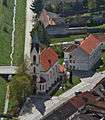Mistelbach
For the town in Germany, see Mistelbach, Bavaria.
| Mistelbach | ||
|---|---|---|
|
| ||
| ||
 Mistelbach Location within Austria | ||
| Coordinates: 48°34′00″N 16°34′00″E / 48.56667°N 16.56667°ECoordinates: 48°34′00″N 16°34′00″E / 48.56667°N 16.56667°E | ||
| Country | Austria | |
| State | Lower Austria | |
| District | Mistelbach | |
| Government | ||
| • Mayor | Dr. Alfred Pohl (ÖVP) | |
| Area | ||
| • Total | 131.38 km2 (50.73 sq mi) | |
| Elevation | 190 m (620 ft) | |
| Population (1 January 2016)[1] | ||
| • Total | 11,314 | |
| • Density | 86/km2 (220/sq mi) | |
| Time zone | CET (UTC+1) | |
| • Summer (DST) | CEST (UTC+2) | |
| Postal code | 2130 | |
| Area code | 02572 | |
| Vehicle registration | MI | |
| Website | www.mistelbach.at | |
Mistelbach an der Zaya (Mistelbach on the (River) Zaya) is a town in the northeast of Austria in so called Lower Austria, one of Austria's nine Federal States. It is located roughly 40 km northeast of Austria's capital Vienna. Furthermore, it consists of 8 subordinated municipalities.
Geographical location
Mistelbach is located in the North East of Lower Austria's Wine Quarter (Weinviertel), approximately 25 to 30 km from the Czech and the Slovak borders. It lies next to the main road connection between Brno (Czech Republic) and Vienna (Road B7).
History
Early settlements in the Mistelbach area can be traced back to pre-Christian times.
Around 1130 Mistelbach was mentioned on official deeds for the first time. After the Lords of Mistelbach had ceased around 1370 the initially royal estates of Wilfersdorf were given to the House of Lichtenstein.
Mistelbach was granted its first right to hold markets in 1372. Today, the town still hosts four markets per year. Mistelbach received its town charter July 5, 1874.
In the 19th century Mistelbach was strongly influenced by its connection to the Austrian Eastern Railway. It eventually became the district's capital and schools were built. In the 20th century Mistelbach experienced difficulties caused by its geographical proximity to the Iron Curtain. Nevertheless, the town developed into a regional center of the Eastern Winequarter (Weinviertel).
Population
According to the 2011 census, Mistelbach had 10,963 residents, compared to a 2001 census population of 10,644. In 1991 Mistelbach counted 10,234 residents, in 1981 10,251 and in 1971 10,235.
Politics
The post of mayor is held by Mr. Alfred Pohl. Mr. Gabauer acts as Chief Municipal Officer. After local elections March 6, 2005 the 37 seats of the Municipal Council are divided as follows: ÖVP (Austrian Christian Democratic Party): 20 seats, SPÖ (Austrian Social Democratic Party): 11 seats, LAB: 3 seats, Green Party of Austria: 2 seats, and FPÖ (Austrian Liberal Party): 1 seat.
Schools
- HTL (Higher Technical School) for Healthcare Technologies
- HAK & HAS (Higher Commercial Academy/Higher Commercial School)
- BORG (Grammar School)
- HS (Public School)
- VS (Elementary School)
- ASO (School for Mentally Handicapped Children)
- Vocational School
- Wine Farmer's School
- Nurse's Training School
Sights
- Gothic Church on Church Hill
- built around 1500, with a gothic Madonna out of sandstone
- Romanic mortuary (Karner)
- built around 1200
- Town Hall
- Trinity Column
- Baroque castle (Barockschlößl) in Museum Lane (Museumsgasse)
- Monastery of the Fraternity of the Barnabiten
- built 1687, with precious ceiling frescos by Kainz, Rossaforte and Maulpertsch
- Column commemorating Mistelbach's suffering under the Black Death (Pestsäule)
- Weather Station in Mistelbach's Town Park
- Town center (Stadtsaal)
- Museum Center Mistelbach
- including the Hermann Nitsch Museum, opened in May 2007[2]
- Hermann Nitsch lives near Mistelbach, in the small village of Prinzendorf. The artist is famous for his unconventional style and for his performance art, for which he also faces considerable criticism.[3]
- Culture Scenery (Kulturlandschaft) around Paasdorf
- Historic Barn (Hofstadl), built in the 19th century in the so-called ship-body style Siebenhirten.[4]
Mistelbach is also home to one of the region's most popular, though traditional Vienna-style coffee houses "Cafe Harlekin" which has become an icon of the city's lifestyle over the years.[5]
Subordinated municipalities
- Ebendorf
- Eibesthal
- Frättingsdorf
- Hörersdorf
- Hüttendorf, within the municipality of Mistelbach
- Kettlasbrunn
- Lanzendorf, within the municipality of Mistelbach
- Paasdorf
- Siebenhirten
Economy and infrastructure
In 2001 there were 583 non-agricultural enterprises in Mistelbach. In 1999 agriculture- and forestry-related enterprises amounted to 281. According to 2001 census data 4,776 people out of the total population worked in Mistelbach. The labor force participation rate is 45.9%.
Gallery


 Siebenhirten, school and church
Siebenhirten, school and church
Notable people
- Oswald Kabasta, conductor
References
External links
| Wikimedia Commons has media related to Mistelbach. |
